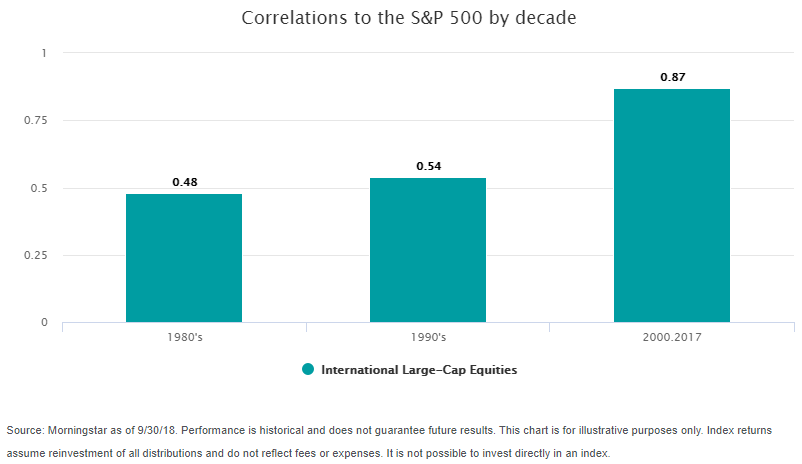Finding uncorrelated assets is often cited as a key part of building a solid portfolio. This helps to increase diversification, which, while it can’t guarantee a profit or eliminate the potential for loss, can potentially help to smooth out the overall return profile.
For many years, investors found their uncorrelated assets abroad, as large cap stocks in foreign markets offered a compelling level of diversification versus the S&P 500. In fact, from 1980-2000, correlations between broad international large cap equities and the S&P 500 hovered around 0.50.
However, markets have been changing in recent years, and large cap stocks abroad no longer offer the same level of diversification that they once did. Since 2000, the correlation between these two major areas of the equity market approached 0.90, hardly enough to offer adequate diversification anymore.

Part of this is due to the rise of exchange-traded funds which have made it far easier for the average investor to buy international securities. Another aspect may be the increasingly globalized world which has made economies—and stocks—so much more interconnected. Whatever the reason, it is clear that international large cap stocks no longer provide the diversification benefits that they once did.
Where are the uncorrelated assets?
Given this trend, what options do investors have when seeking uncorrelated assets? Beyond the old standby of bonds, investors have limited options. Small cap stocks have seen high levels of correlation with the S&P 500, while even emerging markets and high yield bonds have moved in tandem relatively frequently with U.S. large caps.
One area that still retains a low correlation with equities, and is largely overlooked as an asset class by most investors, is commodities. Since the start of 2001, commodities had a correlation of just 0.38 with the S&P 500, possibly making it an excellent diversifying agent compared to many other asset classes or categories:
| Morningstar category | Correlation (1/1/01-9/30/18) |
| Moderate allocation | 0.97 |
| U.S. small cap | 0.88 |
| Conservative allocation | 0.83 |
| Long/short equity | 0.82 |
| Emerging markets | 0.77 |
| U.S. high-yield bonds | 0.66 |
| REITs | 0.63 |
| Commodities | 0.38 |
Source: Morningstar as of 9/30/18. Performance is historical and does not guarantee future results. This chart is for illustrative purposes only. Index returns assume reinvestment of all distributions and do not reflect fees or expenses. It is not possible to invest directly in an index.
